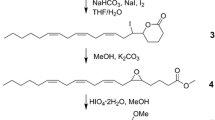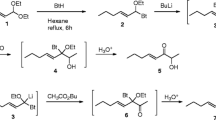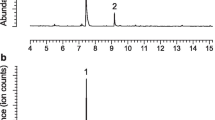Abstract
This is the first fully verified report of an aggregation pheromone produced by a cerambycid beetle species. Field bioassays with adultNeoclytus acuminatus acuminatus (F.) (Coleoptera: Cerambycidae) revealed that males produce a pheromone that attracts both sexes. Extracts of odors from males contained a single major male-specific compound, (2S,3S)-hexanediol. Field trials determined that both sexes were attracted by the racemic blend of (2S,3S)- and (2R,3R)-hexanediols and that activity was similar to enantiomerically enriched (2S,3S)-hexanediol (e.e. 80.2%). However, the blend of all four 2,3-hexanediol stereoisomers attracted few beetles, indicating inhibition by one or both of the (2R*,3S*)-stereoisomers. Females of the cerambycidCurius dentatus Newman were attracted to traps baited with the four component blend, suggesting that a male-produced sex pheromone for this species may contain (2R,3S)-hexanediol and/or (2S,3R)-hexanediol. The pheromone ofN. a. acuminatus, and presumed pheromone ofC. dentatus, bear structural similarities to those produced by males of six other species in the Cerambycinae (straight chains of 6, 8, or 10 carbons with hydroxyl or carbonyl groups at C2 and C3). It is likely that males of other species in this large subfamily produce pheromones that are variations on this structural motif.
Similar content being viewed by others
REFERENCES
Benham, G. S., Jr. and Farrar, R. J. 1976. Notes on the biology of Prionus laticollis (Coleoptera: Cerambycidae). Can. Entomol. 108:569-576.
Bense, U. 1995. Longhorn Beetles: Illustrated Key to the Cerambycidae and Vesperidae of Europe. Margraf Verlag, Weikersheim, Germany.
Bento, J. M. S., Albino, F. E., Della Lucia, T. M. C., and Vilela, E. F. 1992. Field trapping of Migdolus fryanus Westwood (Coleoptera: Cerambycidae) using natural sex pheromone. J. Chem. Ecol. 18:245-251.
Bento, J. M. S., Della Lucia, T. M. C., and Frighetto, R. T. S. 1993. Male response to natural sex pheromone of Migdolus fryanus Westwood (Coleoptera: Cerambycidae) females as affected by daily climatic factors. J. Chem. Ecol. 19:2347-2351.
Boyer, F. D., Malosse, C., Zagatti, P., and Einhorn, J. 1997. Identification and synthesis of vesperal, the female sex pheromone of the longhorn beetle Vesperis xatarti. Bull. Soc. Chim. Fr. 134:757-764.
Edwards, J. S. 1961. Observations on the ecology and behaviour of the huhu beetle, Prionoplus reticularis White. (Col. Ceramb.). Trans. R. Soc. NZ. 88:733-741.
Farrell, B. D. 1998. ″Inordinate fondness″ explained: Why are there so many beetles? Science 281:555-559.
Fauziah, B. A., Tabata, K., Ito, K., Takahashi, S., and Hidaka, T. 1992. Mating behavior of the cryptomeria bark borer, Semanotus japonicus Lacordaire (Coleoptera: Cerambycidae). Appl.Entomol. Zool. 27:19-30.
FettkÖther, R., Dettner, K., SchrÖder, F., Meyer, H., Francke, W., and Noldt, U. 1995. The male pheromone of the old house borer Hylotrupes bajulus (L.) (Coleoptera: Cerambycidae): Identification and female response. Experientia 51:270-277.
Ginzel, M. D., Blomquist, G. J., Millar, J. G., and Hanks, L. M. 2003b. The role of contact pheromones in mate location and recognition in Xylotrechus colonus. J. Chem. Ecol. 29:533-545.
Ginzel, M. D. and Hanks, L. M. 2003. Contact pheromones as mate recognition cues of four species of longhorned beetles (Coleoptera: Cerambycidae). J. Insect Behav. 16:181-187.
Ginzel, M. D., Millar, J. G., and Hanks, L. M. 2003a. (Z)-9-Pentacosene-contact sex pheromone of the locust borer, Megacyllene robiniae. Chemoecology 13:135-141.
Gwynne, D. T. and Hostetler, B. B. 1978. Mass emergence of Prionus emarginatus (Say) (Coleoptera: Cerambycidae). Coleopt. Bull. 32:347-348.
Hall, D. R., Cork, A., Phythian, S., Sumathi, C., Venkatesha, J. M. G., D'Souza, M. V., and Naidu, R. 1998. Studies on the male sex pheromone of the coffee white stemborer, Xylotrechus quadripes Chevrolat (Coleoptera: Cerambycidae), pp. 50-52, in Proceedings of the 2nd International Symposium on Insect Pheromones, Wageningen, The Netherlands, 30 March–3 April 1998.
Hanks, L. M. 1999. Influence of the larval host plant on reproductive strategies of cerambycid beetles. Annu. Rev. Entomol. 44:483-505.
Itami, J. K. and Craig, T. P. 1989. Life history of Styloxus bicolor (Coleoptera: Cerambycidae) on Juniperus monosperma in Northern Arizona. Ann. Entomol. Soc. Am. 82:582-587.
Iwabuchi, K. 1982. Mating behavior of Xylotrechus pyrrhoderus Bates (Coleoptera: Cerambycidae): 1. Behavioral sequences and existence of the male sex pheromone. Appl. Entomol. Zool. 17:494-500.
Iwabuchi, K. 1988. Mating behavior of Xylotrechus pyrrhoderus Bates (Coleoptera: Cerambycidae): VI. Mating system. J. Ethol. 6:69-76.
Iwabuchi, K., Takahashi, J., Nakagawa, Y., and Sakai, T. 1985. Electroantennogram responses of grape borer Xylotrechus pyrrhoderus Bates (Coleoptera: Cerambycidae) to its male sex pheromone components. J. Chem. Ecol. 11:819-828.
Iwabuchi, K., Takahashi, J., Nakagawa, Y., and Sakai, T. 1986. Behavioral responses of female grape borer Xylotrechus pyrrhoderus Bates (Coleoptera: Cerambycidae) to synthetic male pheromone components. Appl. Entomol. Zool. 21:21-27.
Iwabuchi, K., Takahashi, J., and Sakai, T. 1987. Occurrence of 2,3-octanediol and 2-hydroxy-3-octanone, possible male sex pheromone in Xylotrechus chinensis Chevrolat (Coleoptera: Cerambycidae). Appl. Entomol. Zool. 22:110-111.
Kim, G., Takabayshi, J., Takahashi, S., and Tabata, K. 1992. Function of pheromones in mating behavior of the Japanese pine sawyer beetle, Monochamus alternatus Hope. Appl. Entomol. Zool. 27:489-497.
Kolb, H. C., Vannieuwenhze, M. S., and Sharpless, K. B. 1994. Catalytic asymmetric dihydroxylation. Chem. Rev. 94:2483-2547.
Kuwahara, Y., Matsuyama, S., and Suzuki, T. 1987. Identification of 2,3-octanediol, 2-hydroxy-3-octanone, and 3-hydroxy-2-octanone from male Xylotrechus chinensis Chevrolat as possible sex pheromones (Coleoptera: Cerambycidae). Appl. Entomol. Zool. 22:25-28.
Leal, W. S., Bento, J. M. S., Vilela, E. F., and Della Lucia, T. M. C. 1994. Female sex pheromone of the longhorn beetle Migdolus fryanus Westwood: N-(2′S)-methylbutanoyl 2-methylbutylamine. Experentia 50:853-856.
Leal, W. S., Shi, X., Nakamuta, K., Ono, M., and Meinwald, J. 1995. Structure, stereochemistry, and thermal isomerization of the male sex pheromone of the longhorn beetle Anaglyptus subfasciatus. Proc. Natl. Acad. Sci. U.S.A. 92:1038-1042.
Linsley, E. G. 1963. The Cerambycidae of North America, Part 4. Univ. Calif. Publ. Entomol. 21:1-163.
Linsley, E. G. 1964. The Cerambycidae of North America, Part 5. Univ. Calif. Publ. Entomol. 22:1-197.
Linsley, E. G. and Chemsak, J. A. 1997. The Cerambycidae of North America, Part 8. Univ. Calif. Publ. Entomol. 117:1-534.
Nakamuta, K., Leal, W. S., Nakashima, T., Tokoro, M., Ono, M., and Nakanishi, M. 1997. Increase of trap catches by a combination of male sex pheromones and floral attractant in the longhorn beetle, Anaglyptus subfasciatus. J. Chem. Ecol. 23:1635-1640.
Nakamuta, K., Sato, H., and Nakashima, T. 1994. Behavioral and morphological evidence for a male-produced sex pheromone in the cryptomeria twig borer, Anaglyptus subfasciatus Pic (Coleoptera: Cerambycidae). Jpn. J. Entomol. 62:371-376.
Payton, M. E., Greenstone, M. H., and Schenker, N. 2003. Overlapping confidence intervals or standard error intervals: What do they mean in terms of statistical significance? J. Insect Sci. 3:34.
Rao, S., CossÉ, A. A., Zilkowski, B. W., and Bartelt, R. J. 2003. Aggregation pheromone of the cereal leaf beetle: Field evaluation and emission from males in the laboratory. J. Chem. Ecol. 29:2165-2175.
Rhainds, M., Lan, C. C., King, S., Gries, R., Mo, L. Z., and Gries, G. 2001. Pheromone communication and mating behaviour of coffee white stem borer, Xylotrechus quadripes Chevrolat (Coleoptera: Cerambycidae). Appl. Entomol. Zool. 36:299-309.
Sakai, T., Nakagawa, Y., Takahashi, J., Iwabuchi, K., and Ishii, K. 1984. Isolation and identification of the male sex pheromone of the grape borer Xylotrechus pyrrhoderus Bates (Coleoptera: Cerambycidae). Chem. Lett. 1984:263-264.
Sas Institute. 2001. SAS/STAT User's Guide for Personal Computers, Release 8.01. SAS Institute, Cary, NC.
Schlyter, F. and Birgersson, G. A. 1999. Forest beetles, pp. 113-148, in J. Hardie and A. K. Minks (eds.). Pheromones of Non-Lepidopterous Insects Associated with Agricultural Plants. CABI Publishing, Wallingford, United Kingdom.
SchrÖder, F., FettkÖther, R., Noldt, U., Dettner, K., KÖnig, W. A., and Franke, W. 1994. Synthesis of (3 )-3-hydroxy-2-hexanone, (2, 3)-2,3-hexanediol and (2, 3)-2,3-hexanediol, the male sex pheromone of Hylotrupes bajulus and Pyrrhidium sanguineum (Cerambycidae). Liebigs Ann. Chem. 1994:1211-1218.
Shelly, T. E. and Whittier, T. S. 1997. Insect lek behavior, pp. 273-293, in J. C. Choe and B. J. Crespi (eds.). The Evolution of Mating Systems in Insects and Arachnids. Cambridge University Press, Cambridge, United Kingdom.
Sokal, R. R. and Rohlf, F. J. 1995. Biometry, 3rd edn. W. H. Freeman, New York.
Solomon, J. D. 1995. Guide to Insect Borers in North American Broadleaf Trees and Shrubs. USDA Forest Service Agriculture Handbook 706, Washington, DC.
Svacha, P. and Danilevsky, M. L. 1987. Cerambycoid larvae of Europe and Soviet Union (Coleoptera, Cerambycoidea). Part 1. Acta Univ. Caroliniae, Biol. 30:1-176.
Wang, Q., Li, J., Zeng, W., and Yin, X. 1991. Sex recognition by males and evidence for a female sex pheromone in Paraglenea fortunei (Coleoptera: Cerambycidae). Ann. Entomol. Soc. Am. 84:107-110.
Yanega, D. 1996. Field Guide to Northeastern Longhorned Beetles (Coleoptera: Cerambycidae). Manual 6, Illinois Natural History Survey, Urbana, Illinois.
Zhang, A., Oliver, J. E., Aldrich, J. R., Wang, B., and Mastro, V. C. 2002. Stimulatory beetle volatiles for the Asian longhorned beetle, Anoplophora glabripennis (Motschulsky). Z. Naturforsch. 57c:553-558.
Author information
Authors and Affiliations
Rights and permissions
About this article
Cite this article
Lacey, E.S., Ginzel, M.D., Millar, J.G. et al. Male-Produced Aggregation Pheromone of the Cerambycid Beetle Neoclytus acuminatus acuminatus . J Chem Ecol 30, 1493–1507 (2004). https://doi.org/10.1023/B:JOEC.0000042064.25363.42
Issue Date:
DOI: https://doi.org/10.1023/B:JOEC.0000042064.25363.42




